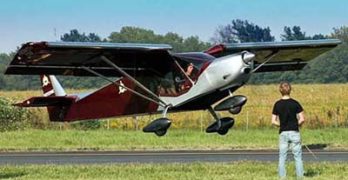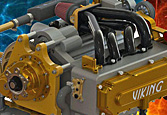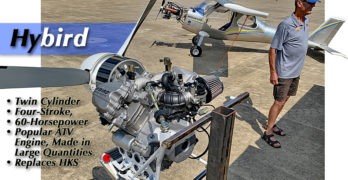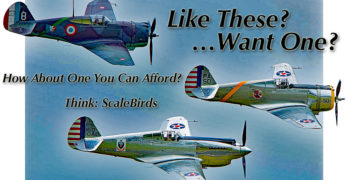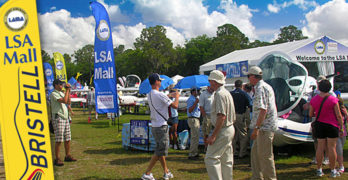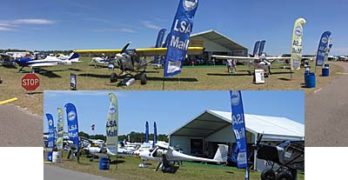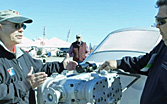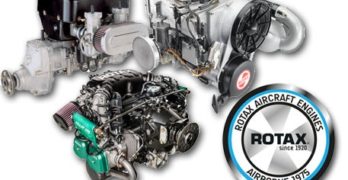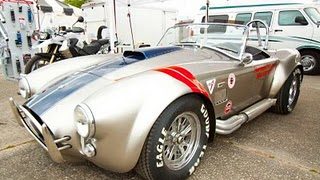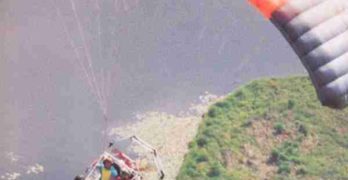Engine suppliers must love Zenith Aircraft, perhaps as much as their many airframe owners. For 23 years, the kit company based in Mexico, Missouri has supplied about 200 kits per year to buyers all over the country and around the world. That is a selling performance any light airplane company would like to boast. One reason for their success is their support of a variety of engines, no small feat considering each engines has special qualities to be considered when installing and using them. Good for Zenith for going the extra mile. One of the many engines they support is the Viking Aircraft Engine from Edgewater, Florida on the Atlantic side of the Sunshine State. Zenith also supports engines from Rotax, Jabiru, UL Power, and Continental. See the video below covering the short field takeoff and landing competition on a pretty, sunny day at the Mexico airport.
Search Results for : Viking engine
Not finding exactly what you expected? Try our advanced search option.
Select a manufacturer to go straight to all our content about that manufacturer.
Select an aircraft model to go straight to all our content about that model.
Viking’s 110-hp Engine
One of the difficult things to do in aviation is to introduce a new engine. Everyone (rightfully) wants to be pretty certain the new powerplant can hold up to steady duty. Therefore, it is common for the Experimental Amateur Built community to experiment first and to provide valuable “field testing” that shows the merits. Viking Engine’s Jan Eggenfellner shows us around the engine and answers some of the questions anyone would ask.
Welcome Hybird — New Four-Stroke Engine for Light Aircraft; Replaces HKS
A new engine was debuted at Midwest LSA Expo 2020 for light aircraft from Aeromarine-LSA. Paired as it is with a new engine-specific prop, this is a refreshing bit of news for ultralight enthusiasts and other single seat light aircraft lovers.
It’s called Hybird… and, no, I did not spell that incorrectly. As you’ll hear, the new powerplant has some possibility to be a form of hybrid (this time spelled as you expect) but it is different in that respect, too.
Since HKS decided to exit airplane engines — although our favorite datastician, Steve Beste reports he can still get parts for his HKS — the light aircraft industry has had an ear to the ground for a new four stroke replacement. It appears Chip Erwin has what many are seeking.
HyBIRD, not Hybrid
As those who know him realize, Chip does not just go out and find components for his airplanes and then adapt them to his designs.
Vintage Light Kit Aircraft Heaven — Checking out ScaleBirds’ Curtis P-36 with 5-Cylinder Engine
ScaleBirds is not your run-of-the-mill kit aircraft company. In truth, all kit builders are amazing to me.
People who labor for years to design an aircraft, craft methods for making the constituent parts, assemble it all, work out bugs in construction, fly the aircraft, then smooth any rough edges of its flight qualities, start producing kit components — and the manual it will take for a non-expert to build the kit (perhaps the hardest task) — and finally, start the effort of telling people about the airplane, market it, sell it — and the big one — try to turn a profit for doing all the preceding. Any way you cut it, birthing a new design is an immense project.
Sam Watrous, his son Scott, and their merry band of (mostly volunteer) ScaleBirders are not merely doing all the above. They are emulating vintage American military designs in reduced scale and trying to get the details right so the kit versions look as much as possible like the originals.
Ready for Sun ‘n Fun 2019 — Airplanes and Engines on Display in LSA Mall
This year celebrates 15 years of Light-Sport Aircraft and its companion pilot certificate, Sport Pilot. This year also celebrates the 12th year of LAMA providing the LSA Mall. What a fascinating ride it has been!
For 2019, LAMA will again host its special location at the big spring celebration of flight that is Sun ‘n Fun. LAMA is able to mount this attraction thanks to longstanding support from Sun ‘n Fun management and many industry players.
The purpose of the LSA Mall is twofold: (1) present aircraft to visitors in a convenient, enjoyable setting, and (2) showcase the light aircraft industry in one location. The LSA Mall is not limited to Special Light-Sport Aircraft but features Sport Pilot-eligible kit aircraft and ultralights plus specialty light aircraft that may be of interest to pilots.
For 2019, the LSA Mall will add a few previously-owned LSA, as this part of the light aircraft market is developing.
Full LSA Mall and Engines of Light Aircraft
Here at the Sun ‘n Fun 2017 airshow LAMA’s LSA Mall is full and strong with 13 aircraft gathered from some of the leading brands. This exhibit was paired with the first-ever “Engines of Light Aircraft” display inside a large LAMA “Show Center” tent. On the first days of the Lakeland show, people appeared to be receiving the idea warmly.
One brand, Tecnam of Italy, showed its strength in the light aircraft community with three aircraft represented, two from First Landings at Apopka Airport in Florida and one from Lockwood Aircraft. The former are used in an active Sport Pilot school and the latter is a great example of the durability of Light-Sport Aircraft. The example from Lockwood has 4,500 hours on it and looks brand new.
Beside Tecnam, aircraft included Zlin’s Shock, BRM Aero’s Bristell, Progressive Aerodyne’s Searey, AeroJones’ CTLS, Pipistrel’s Virus SW, Aerotrek’s A-240, TL Ultralight’s Sting, Lockwood’s AirCam, and a Rans S-7 powered by Viking Engines.
D Motor — LF39 LSA engine
You already know very well Rotax, Jabiru, Continental, and Lycoming plus a couple others including UL Power and Viking. Now, come have a look and listen to Doc Bailey telling us about the D-motor, a flat head engine. D Motor is a direct drive, horizontally opposed, gasoline engine with what Dac’ said is only 35 moving parts. Here’s 95 horsepower weighing only 124 pounds with a high torque, 250 newton meters’ worth. Created by former race car drivers specifically for aircraft, D Motor has many of the features pilots want.
Forty Years of Rotax Aircraft Engines
Aircraft engine giant, Rotax BRP has reached an anniversary: forty years of making powerplants used around the world by airframe makers of ultralights to Very Light Aircraft. Thus, it was hardly a surprise when Light-Sport Aircraft came along eleven years ago that the Austrian company immediately became the largest supplier of engines … capturing an estimated 80% of the market, even while other ASTM-approved engines are in use from Continental, Jabiru, Lycoming, and HKS. New candidates include Superior’s Gemini Diesel and, of course, the ECi Titan 180-horsepower engine has seen good acceptance. Then we have another batch of engines for kit-built aircraft including Viking (based on Honda), UL-Power, AeroVee (VW), AeroMomentum (Subaru), Corvair, and more.
Despite the many other choices, Rotax has retained a dominant position. I’ve long felt that while it can be challenging to bring a new airframe to market and win some customers, it is even harder to introduce a new engine.
Honda-based Engine For Rotax Mounts
While talking to an enterprising Dutchman who markets several non-aviation, but exceptionally beautiful road machines and accessories (Can you dig a gorgeous, classic Carroll Shelby replica Cobra signed by the great man himself for $60,000?), he pointed to a man walking by and said, “There goes Eggenfellner, he makes a beautiful modified Honda engine for LSA.” *** A couple minutes later I wondered over to the motorhead’s booth and saw this gorgeous engine package, based on an inline 4-cylinder Honda automotive engine (he also builds a Subaru-based mill), that is finding its way into a number of experimental aircraft that take Rotax engines. *** The liquid-cooled Viking HF-110 has 9 more cubic inches displacement than a Rotax 912 ULS, weighs 31 lbs. more, and produces 14 more horsepower at 75% power and 15 more hp at takeoff rpm of 5400 – 400 less than the Rotax. *** It also has a 12 month/100 hour money-back guarantee (Rotax: 6 months and 100 hours) and costs $9,900 – and comes with alternator, ignition and fuel injection, exhaust, air intake, starter, radiator, prop drive unit and engine mounting brackets to align with existing Rotax airframe mounts.
St. Andrews Aviation — Viking II
St. Andrews Aviation boss Charles Dozier calls his new Viking II a “parachute plane” rather than simply a powered parachute. In one particular way it certainly isn’t like those which preceded the new aircraft: Viking II employs side-by-side seating in the first such example with which I’m aware among powered parachute aircraft. For those doing training in these machines, such side seating is usually considered optimal so the instructor can better interact with his student.
Ground steering is also made intuitive by employing a steering bar that works the way a bicycle does (whereas many powered parachutes use a joystick-type control for ground handling). Because the seats are alongside one another, Dozier was also able to centralize the throttle and nosewheel brake. Another benefit, says the designer, is a lowered center of gravity because the student or other occupant is not raised above and behind as in most powered parachutes.
For in-air steering – which requires the use of your feet on powered parachutes – the Viking II has a dual set of foot pedals such that either occupant can fly the machine while the other observes.
- 1
- 2
- 3
- …
- 5
- Next Page »


